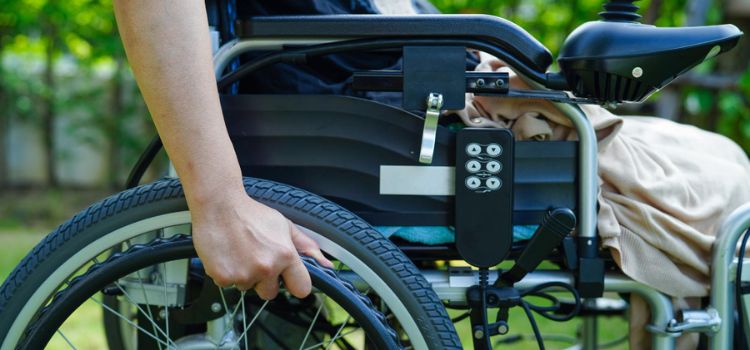In mobility aids, the transport manual wheelchair symbolizes independence and freedom for individuals with limited mobility. Whether you’re a seasoned user or a caregiver seeking guidance, this comprehensive guide will take you through transport manual wheelchairs. We’ll explore the key features, benefits, maintenance tips, and much more to empower you with knowledge about this essential mobility tool.
Understanding the Transport Manual Wheelchair
Before we dive into the details, let’s get acquainted with the basics. A transport manual wheelchair, often referred to as a manual wheelchair, is a self-propelled wheelchair designed for individuals who can use their upper body strength to move around independently or with the assistance of a caregiver. These wheelchairs come in various styles and configurations, each tailored to meet specific needs.
These wheelchairs typically feature a sturdy frame, two large rear wheels for self-propulsion, and two smaller front wheels for stability and maneuverability. The seat is ergonomically designed for comfort and often cushioned for extended use. The user can control their direction and speed by pushing the large rear wheels, offering a level of independence that’s truly liberating.
Benefits of a Transport Manual Wheelchair

- Enhanced Mobility: Perhaps the most significant advantage of a manual transport wheelchair is the independence it provides. Users can move around freely, indoors or outdoors, without needing a power source or assistance from others.
- Low Maintenance: Manual wheelchairs are relatively low maintenance compared to their powered counterparts. They don’t require charging, and fewer components can malfunction.
- Affordability: Manual wheelchairs are often more budget-friendly than electric wheelchairs, making them an excellent choice for those on a tight budget or without insurance coverage.
- Compact and Portable: Many transport manual wheelchairs are designed to be foldable and lightweight, making them easy to transport in a car or store when not in use.
Choosing the Right Transport Manual Wheelchair
Selecting a suitable manual wheelchair is crucial for ensuring comfort, safety, and ease of use. Here are some factors to consider when making your choice:
- Wheelchair Type: Manual wheelchairs come in various types, including standard, lightweight, and transport chairs. Consider your specific needs and the intended use to determine which style suits you best.
- Seat Size and Comfort: Opt for a wheelchair with a comfortable and appropriately sized seat. This ensures you can sit comfortably for extended periods without developing pressure sores.
- Weight Capacity: Be sure to choose a wheelchair that can accommodate your weight or the weight of the person for whom it’s intended. Exceeding weight limits can lead to safety issues and premature wear and tear.
- Wheel Size: The size of the wheels affects maneuverability. Smaller wheels provide better maneuverability in tight spaces, while larger wheels are better for outdoor use.
- Foldability and Portability: If you plan to transport the wheelchair frequently, consider a foldable and lightweight model for convenience.
Transport Manual Wheelchairs for Travel

Traveling with a transport manual wheelchair can be a breeze with the proper preparation and equipment. Here’s how to ensure smooth journeys:
- Air Travel: When flying, inform the airline about your wheelchair needs. Most airlines have policies to accommodate manual wheelchairs and provide assistance if required.
- Accessible Vehicles: Ensure that the transportation you plan to use at your destination can accommodate your wheelchair. Many taxis and rental cars are now equipped with ramps or lifts.
- Pack Wisely: Carry essential wheelchair accessories, such as cushions, toolkits, and spare parts, in case of unexpected issues during your trip.
- Accessible Accommodations: When booking accommodations, inquire about accessible rooms and bathrooms to make your stay as comfortable as possible.
Maintaining Your Transport Manual Wheelchair
Proper maintenance is critical to extending the lifespan and ensuring the safety of your manual transport wheelchair. Here’s a maintenance checklist:
- Regular Cleaning: Wipe down the frame, wheels, and seat regularly to prevent the buildup of dirt and debris.
- Inspect for Wear and Tear: Check for loose bolts, worn-out tires, and damaged components. Address any issues promptly to prevent accidents.
- Lubrication: Keep the moving parts, such as the wheels and axles, well-lubricated to ensure smooth operation.
- Tire Maintenance: Check tire pressure regularly and inflate them to the recommended level to maintain optimal performance.
- Battery Maintenance (if applicable): If your manual wheelchair has a power-assist feature, follow the manufacturer’s guidelines for battery maintenance.
Accessories and Customization
Personalizing your manual transport wheelchair can enhance both its functionality and style. Some popular accessories and customization options include:
- Cushions and Seating: Choose cushions and seating options that provide maximum comfort and support, especially if you spend long hours in your wheelchair.
- Storage Solutions: Add bags, pouches, or under-seat storage to conveniently carry personal items and necessities.
- Wheelchair Ramps: Portable ramps can help you navigate steps and curbs more efficiently, increasing mobility.
- Grips and Handles: Customize the grips and handles to suit your preferences, ensuring a comfortable and ergonomic fit.
- Wheelchair Lights: Attach lights for added visibility and safety, especially when using your wheelchair outdoors in low-light conditions.
Staying Active with a Transport Manual Wheelchair
A manual transport wheelchair can be a powerful tool for staying active and engaged in various activities. Here’s how:
- Adaptive Sports: Explore adaptive sports like wheelchair basketball, tennis, or racing, which offer excellent opportunities for physical activity and social interaction.
- Fitness and Exercise: Many fitness centres and trainers offer wheelchair-friendly workout programs to help you stay in shape.
- Outdoor Adventures: Enjoy nature and outdoor adventures by exploring accessible hiking trails and parks. Some locations even offer adaptive equipment for rent.
- Community Involvement: Join local disability support groups and organizations that offer recreational activities and events designed for wheelchair users.
Navigating Everyday Challenges

While a manual transport wheelchair empowers you with mobility, it’s essential to address the challenges you may encounter in everyday life:
- Accessibility: Advocate for improved accessibility in your community, from ramps and curb cuts to accessible public transportation.
- Workplace Accommodations: If you’re employed, discuss accommodations that can make your job more comfortable, such as accessible desks and ramps.
- Healthcare Access: Ensure that your healthcare providers and facilities are accessible and that medical equipment, like examination tables, can accommodate your wheelchair.
Your Transport Manual Wheelchair: A Gateway to Independence
In conclusion, a transport manual wheelchair is more than just a mobility aid; it’s a gateway to independence, freedom, and an active lifestyle. You can unlock a world of possibilities by understanding its benefits, choosing the suitable model, maintaining it diligently, and personalizing it to your needs.
